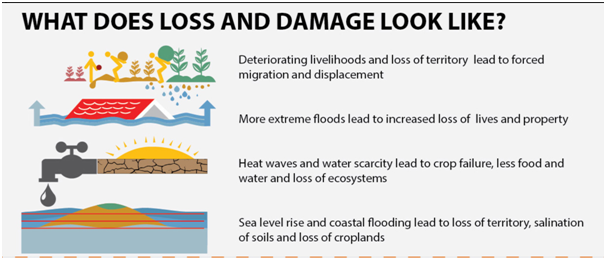Loss and Damage
Context: The Environment Minister recently stated that for many developing countries, who have contributed little to climate change, the severe impacts of climate change are looming large over their existence.
What is Loss and Damage?
- Loss and damage refers to the negative consequences that arise from the unavoidable risks of climate change, like rising sea levels, prolonged heatwaves, desertification, the acidification of the sea and extreme events, such as bushfires, species extinction and crop failures.
- As the climate crisis unfolds, these events will happen more and more frequently, and the consequences will become more severe.
- It can come from slow-moving disasters, like sea level rise and ocean acidification, caused mainly or entirely by climate change
- Loss and damage is often framed as a matter of climate justice—noting that the low-income nations that have done the least to cause climate change also have the fewest resources to withstand it.
- For example, The African continent contributes the least to climate change yet is the most vulnerable to its impacts.
- In the early 1990s, a group of small island nations, realising their vulnerability to rising seas, lobbied for the UNFCCC to include a fund through which the wealthy nations most responsible for climate change would compensate the hardest-hit nations for the “loss and damage” from sea level rise.
Challenges of loss and damage
- Any effort to measure loss and damage will involve putting a value not only on property damage and loss of livelihood, but also on “non-economic losses.
- That can include human lives, the loss of species, and even the loss of places and cultures (the melting of sea ice takes away the hunting traditions of Indigenous people in the Arctic)
- A full accounting of loss and damage must also wrestle with the role of climate change in disasters that may have multiple causes.
Responses to loss and damage
- Compensation for loss and damage remains an active point in climate negotiations.
- The Loss and Damage Fund was established at the United Nations Climate Conference (COP 27). The fund aims to provide financial assistance to nations most vulnerable and impacted by the effects of climate change.
- Recently, Denmark became the first country to offer aid explicitly for loss and damage.
What is UNEP doing to combat loss and damage?
- UNEP produces up-to-date, accurate science and knowledge on the impact of climate change.
- For e.g. UNEP’s landmark studies such as the Emissions Gap Report and the Adaption Gap Report, provide critical information to policymakers around the world.
- The organisation is currently supporting over 50 ecosystem-based adaptation projects.
- These projects aim to restore around 113,000 hectares and benefit around 2.5 million people worldwide.
- UNEP is also supporting demand-driven technical assistance to climate information such as early warning systems and capacity building in countries such as Timor-Leste, Azerbaijan, El Salvador, Ghana, Maldives, Sudan and the Pacific island developing states.
Will the Loss and Damage Fund be effective?
- It is important that a Loss and Damage Fund tackles the gaps that current climate finance institutions such as the Green Climate Fund do not fill.
- Combined adaptation and mitigation finance flows in 2020 fell at least US$17 billion short of the US$100 billion pledged to developing countries.
- The Transitional Committee will provide recommendations for the set up and operations of the fund.
- The Committee will also recommend which countries should receive funding and who should be paying into the fund.
To make the fund effective, the root cause of climate change must be tackled – and that involves reducing emissions. Unless emissions are drastically reduced, more and more countries will face the devastating effects of climate change. The world urgently needs to find more resources for mitigation, adaptation and loss and damage so that climate change will not erode humanity’s chances to deliver on the Sustainable Development Goals.
| Practice Question
1. What is loss and damage? Also list the measures by international organisations to curb it? |





